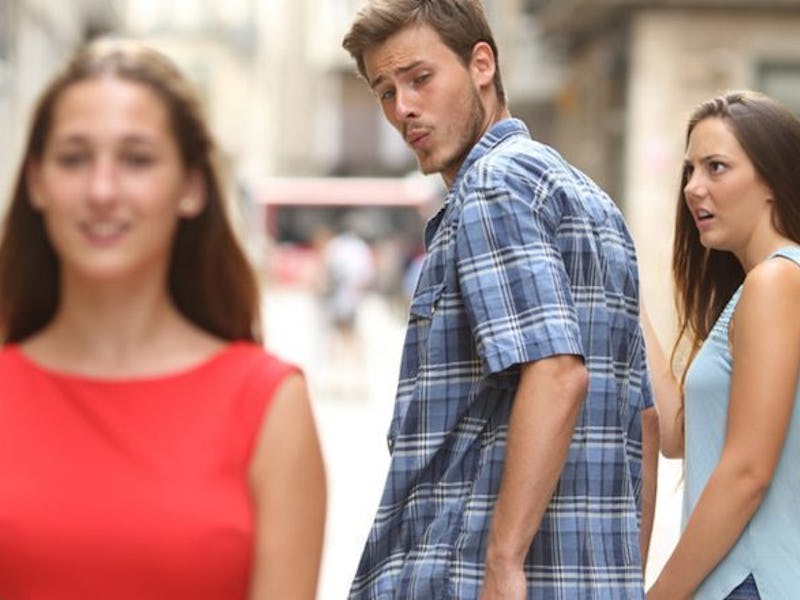Meet the Photographer Whose Work Created the "Disloyal Man" Meme
"I never thought that one of my images will be that popular."

Few memes have ever broken containment and gone viral like the “disloyal man” meme did last week. What the photo depicts is simple enough: A man turns in obvious, horndog admiration of a woman walking past, much to the outraged disgust of his partner.
Onto that rich canvas people have projected endless jokes: The man checks out socialism over capitalism, standalone TV episodes over endlessly serialized arcs, new books at the bookstore over all the books he already has, and countless more. Not bad for a stock photo taken as part of a standard advertising shoot in Spain in 2015.
“I never thought that one of my images will be that popular,” Antonio Guillem, the 45-year-old photographer behind the internet’s hottest meme, tells Inverse in an email. “I didn’t even know what a meme is until recently, when the models started to tell me about the memes that people were doing with our work.”
Living and working in Barcelona, Guillem says he started working in ad photography five years ago without any previous experience. He now puts in 16 hours a day creating stock images with his models.
This particular photo came out of a session in Girona, about 90 minutes northeast of Barcelona. The first, nascent hints of the image’s future virality might be found in the looseness of the shoot. “Because we were having a great sales response to our work, we decided to take a few risks planning a session representing the infidelity concept in relationships in a playful and fun way,” says Guillem.
It’s hard to imagine the meme would have ever taken off if not for that sense of playfulness — no matter how funny a Twitter user’s captions might be, the joke wouldn’t pop without those comically exaggerated expressions from the boyfriend and girlfriend. On that score, Guillem might have had to concede defeat on the day, even as it proved pivotal to the image’s future unexpected success.
“It was quite challenging to achieve face expressions that were believable,” says Guillem, “mainly because we always have a really great work atmosphere and almost all the time one of the models was laughing while we were trying to take the picture.”
He credits the success of the photo — both as a profitable bit of stock photography and as the fodder for the latest internet-breaking meme — to his close working relationship with his models. While he stopped working with one of the women in the photo last year, he has been working with the other two models consistently for about the past five years.
“I care about them as [if] they were my kids,” he says. “It’s not just saying, we have a real emotional bond that exists both inside and outside work. They know that [they can] count on me for anything and the same about them. They work exclusively for me and they are as great people as their work is. They are extremely professional and responsible, always willing to do whatever it’s necessary. I can’t ask for anything else. We have complete trust and confidence in each other.”
For Guillem and his models, stock photography is fundamentally a business, and their overriding interest is in creating work that sells. He says his team sells 1,600 photos a day.
“We work exclusively creating advertisement photography for image banks,” he says. “Our top selling images get more than 5,000 to 6,000 sales a year, while the meme photo is sold around 700 times a year.”
That kind of success gives them the luxury of taking risks, and this meme is the natural outgrowth of that kind of weird creativity.
“As you can imagine, we can’t worry about each one of the particular uses that have been given to our photos, as we focus on creating content that can be sold thousands of times, even though the meme situation can be surprising,” he says. “The models discovered the meme on social media and they told me about it. None of us could image the media repercussion that it has reached right now.”
Even though the internet suddenly knows all about their work, Guillem says he and his models haven’t seen many benefits from the meme. After all, those posting images on Twitter aren’t buying a license from Shutterstock or another agency. “The sales that are related with the memes are probably a 0.00000% of our monthly revenue,” he says. “It’s not relevant.”
That does mean those posting the memes are effectively stealing Guillem’s work. However, he says there are no plans to take legal action as long as people making the memes are doing so in good faith. “What really worries us and we are not going to allow it, taking the appropriate legal measures, is the use of the images in a pejorative, offensive or any way that can harm the models or me,” he says.
Fair warning for potential memers: If you’re thinking of replacing the models’ faces with something else, Guillem is not cool with that. “I’m talking, for example, about the image where their faces are changed by a dog face, a garbage bag, and a dog food bag.”
Largely, though, he’s philosophical about the meme’s virality, downplaying his team’s work in its sudden internet omnipresence.
“Regarding what I think about the photo has gone viral, I think the image was a good foundation to whoever had the great idea to turn it into a metaphor that works for almost everything,” he says. “And that’s not our merit.”
That seems an unnecessarily modest view. If this entire episode has revealed anything, it’s that the makings of universal, instantly relatable stock photography and an infinitely shareable meme share a common artistic thread.